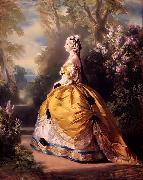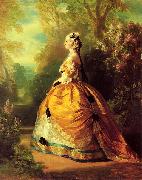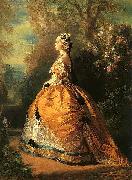Wholesale Oil Painting No Minimum |
|||||||||||
|
|
|||||||||||

|
|||||||||||
|
|
|
||||||||
Franz Xaver WinterhalterGerman 1805-1873 Franz Xaver Winterhalter Galleries German painter and lithographer. He trained as a draughtsman and lithographer in the workshop of Karl Ludwig Scheler (1785-1852) in Freiburg im Breisgau and went to Munich in 1823, sponsored by the industrialist Baron Eichtal. In 1825 he began a course of study at the Akademie and was granted a stipend by Ludwig I, Grand Duke of Baden. The theoretical approach to art of the Akademie under the direction of Peter Cornelius was unfamiliar to him, as in Freiburg he had been required to paint in a popular style. He found the stimulus for his future development in the studio of Joseph Stieler, a portrait painter who was much in demand and who derived inspiration from French painting. Winterhalter became his collaborator in 1825. From Stieler he learnt to make the heads of figures emerge from shadow and to use light in the modelling of faces. He moved to Karlsruhe in 1830 with his brother Hermann Winterhalter (1808-92), who had also trained with Scheler and had followed him to Munich. |
||||||||
|
|
||||||||
The Empress Eugenie
The Empress Eugenie Painting ID:: 593 |
1854 1854 |
|||||||
|
|
||||||||
Franz Xaver WinterhalterGerman 1805-1873 Franz Xaver Winterhalter Galleries German painter and lithographer. He trained as a draughtsman and lithographer in the workshop of Karl Ludwig Scheler (1785-1852) in Freiburg im Breisgau and went to Munich in 1823, sponsored by the industrialist Baron Eichtal. In 1825 he began a course of study at the Akademie and was granted a stipend by Ludwig I, Grand Duke of Baden. The theoretical approach to art of the Akademie under the direction of Peter Cornelius was unfamiliar to him, as in Freiburg he had been required to paint in a popular style. He found the stimulus for his future development in the studio of Joseph Stieler, a portrait painter who was much in demand and who derived inspiration from French painting. Winterhalter became his collaborator in 1825. From Stieler he learnt to make the heads of figures emerge from shadow and to use light in the modelling of faces. He moved to Karlsruhe in 1830 with his brother Hermann Winterhalter (1808-92), who had also trained with Scheler and had followed him to Munich. |
||||||||
|
|
||||||||
|
|
The Empress Eugenie
The Empress Eugenie Painting ID:: 78138 |
1854(1854)
Oil on canvas
92.7 x 73.7 cm (36.5 x 29 in)
cjr 1854(1854) Oil on canvas 92.7 x 73.7 cm (36.5 x 29 in) cjr |
||||||
|
|
||||||||
Franz Xaver WinterhalterGerman 1805-1873 Franz Xaver Winterhalter Galleries German painter and lithographer. He trained as a draughtsman and lithographer in the workshop of Karl Ludwig Scheler (1785-1852) in Freiburg im Breisgau and went to Munich in 1823, sponsored by the industrialist Baron Eichtal. In 1825 he began a course of study at the Akademie and was granted a stipend by Ludwig I, Grand Duke of Baden. The theoretical approach to art of the Akademie under the direction of Peter Cornelius was unfamiliar to him, as in Freiburg he had been required to paint in a popular style. He found the stimulus for his future development in the studio of Joseph Stieler, a portrait painter who was much in demand and who derived inspiration from French painting. Winterhalter became his collaborator in 1825. From Stieler he learnt to make the heads of figures emerge from shadow and to use light in the modelling of faces. He moved to Karlsruhe in 1830 with his brother Hermann Winterhalter (1808-92), who had also trained with Scheler and had followed him to Munich. |
||||||||
|
|
||||||||
|
|
The Empress Eugenie
The Empress Eugenie Painting ID:: 78343 |
Date 1854(1854)
Medium Oil on canvas
Dimensions 92.7 x 73.7 cm (36.5 x 29 in)
cjr Date 1854(1854) Medium Oil on canvas Dimensions 92.7 x 73.7 cm (36.5 x 29 in) cjr |
||||||
|
|
||||||||
Franz Xaver WinterhalterGerman 1805-1873 Franz Xaver Winterhalter Galleries German painter and lithographer. He trained as a draughtsman and lithographer in the workshop of Karl Ludwig Scheler (1785-1852) in Freiburg im Breisgau and went to Munich in 1823, sponsored by the industrialist Baron Eichtal. In 1825 he began a course of study at the Akademie and was granted a stipend by Ludwig I, Grand Duke of Baden. The theoretical approach to art of the Akademie under the direction of Peter Cornelius was unfamiliar to him, as in Freiburg he had been required to paint in a popular style. He found the stimulus for his future development in the studio of Joseph Stieler, a portrait painter who was much in demand and who derived inspiration from French painting. Winterhalter became his collaborator in 1825. From Stieler he learnt to make the heads of figures emerge from shadow and to use light in the modelling of faces. He moved to Karlsruhe in 1830 with his brother Hermann Winterhalter (1808-92), who had also trained with Scheler and had followed him to Munich. |
||||||||
|
|
||||||||
|
|
The Empress Eugenie
The Empress Eugenie Painting ID:: 80764 |
1854
Medium Oil on canvas
Dimensions 92.7 x 73.7 cm
cyf 1854 Medium Oil on canvas Dimensions 92.7 x 73.7 cm cyf |
||||||
|
|
||||||||
Franz Xaver WinterhalterGerman 1805-1873 Franz Xaver Winterhalter Galleries German painter and lithographer. He trained as a draughtsman and lithographer in the workshop of Karl Ludwig Scheler (1785-1852) in Freiburg im Breisgau and went to Munich in 1823, sponsored by the industrialist Baron Eichtal. In 1825 he began a course of study at the Akademie and was granted a stipend by Ludwig I, Grand Duke of Baden. The theoretical approach to art of the Akademie under the direction of Peter Cornelius was unfamiliar to him, as in Freiburg he had been required to paint in a popular style. He found the stimulus for his future development in the studio of Joseph Stieler, a portrait painter who was much in demand and who derived inspiration from French painting. Winterhalter became his collaborator in 1825. From Stieler he learnt to make the heads of figures emerge from shadow and to use light in the modelling of faces. He moved to Karlsruhe in 1830 with his brother Hermann Winterhalter (1808-92), who had also trained with Scheler and had followed him to Munich. |
||||||||
|
|
||||||||
|
|
The Empress Eugenie
The Empress Eugenie Painting ID:: 81600 |
1854(1854)
Medium Oil on canvas
Dimensions 92.7 x 73.7 cm (36.5 x 29 in)
cyf 1854(1854) Medium Oil on canvas Dimensions 92.7 x 73.7 cm (36.5 x 29 in) cyf |
||||||
|
|
||||||||
|
Franz Xaver Winterhalter German 1805-1873 Franz Xaver Winterhalter Galleries German painter and lithographer. He trained as a draughtsman and lithographer in the workshop of Karl Ludwig Scheler (1785-1852) in Freiburg im Breisgau and went to Munich in 1823, sponsored by the industrialist Baron Eichtal. In 1825 he began a course of study at the Akademie and was granted a stipend by Ludwig I, Grand Duke of Baden. The theoretical approach to art of the Akademie under the direction of Peter Cornelius was unfamiliar to him, as in Freiburg he had been required to paint in a popular style. He found the stimulus for his future development in the studio of Joseph Stieler, a portrait painter who was much in demand and who derived inspiration from French painting. Winterhalter became his collaborator in 1825. From Stieler he learnt to make the heads of figures emerge from shadow and to use light in the modelling of faces. He moved to Karlsruhe in 1830 with his brother Hermann Winterhalter (1808-92), who had also trained with Scheler and had followed him to Munich. The Empress Eugenie 1854(1854) Medium Oil on canvas Dimensions 92.7 x 73.7 cm (36.5 x 29 in) cyf |
||||||||
|
|
||||||||
|
Prev Next
|
||||||||
|
|
||||||||
|
Related Paintings to Franz Xaver Winterhalter :. |
||||||||
|
|
||||||||
|
CONTACT US |





